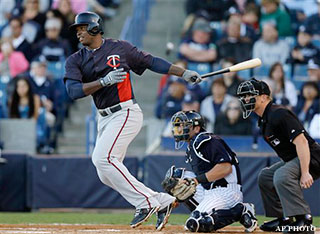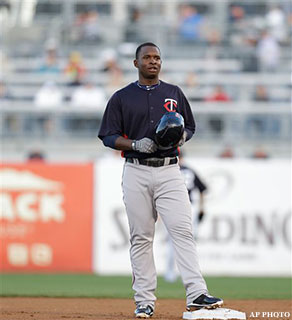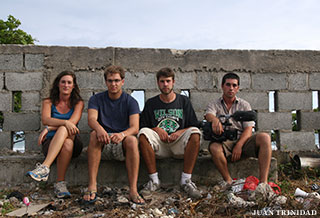
The first time Ross Finkel heard the vicious crack of Miguel Sano's bat, he knew he was on to something extraordinary.
To this day, Finkel can't shake the sound. It was sweet and disturbing at the same time. A blend of unfathomable baseball talent and a powerful and violent pop that reverberated his bones and that -- as far as he was concerned -- had no business coming out of a 15-year-old kid.
Maybe Finkel should have known he had stumbled onto greatness that day. He and his fellow documentary film-making friends had made all the wrong turns trying to locate the baseball showcase in the middle of a busted-up neighborhood in the Dominican Republic. But the fact the chaos surrounding the spectacle came to an absolute stop as soon as Sano made his way to the plate should have alerted Finkel that his life was about to change.
As soon as Finkel begins to think back when he first laid eyes on Miguel Sano, the noise -- that unforgettable crack -- pops back into his head. And suddenly, what started as a two-week trip to the D.R. in 2008 to film a short documentary on Latin American baseball and that five years later has no end in sight, now all makes sense.
And so does that crack of the bat.
"As soon as we saw Miguel, we had an inkling that this kid was special," Finkel says. "The way people talked about him, the way looked at him, the way he carried himself, it just seemed this kid was destined for the big leagues."
As it turns out, the story was just beginning.
Not only for Sano, but for the three young filmmakers whose lives have been turned upside down capturing the Minnesota Twins' top minor league prospect's journey on film.
As Finkel, Jon Paley and Trevor Martin began work on "Ballplayer: Pelotero," a feature length documentary that debuted in 2012, it quickly became evident that Sano would somehow factor into their storytelling.

Almost immediately upon arriving in the D.R, the aspiring artists discovered that encapsulating baseball in a country that produces 20 percent of MLB players would be no easy task. The country was known for being a baseball factory, where talented players hell bent on making a better life for themselves and their families told a familiar story.
But as romantic as the setting seemed, they also found themselves wrapped up in age controversies and stories of agents and trainers eager to make a name for themselves by promising the world to young ballplayers. They discovered a country where corruption was standard practice and where one's word didn't necessarily carry much weight.
They filmed what they saw, careful not to embellish a thing, but instead, capture what it was like to try reaching the major leagues out of such humble beginnings.
Once completed, "Pelotero" was criticized by MLB commissioner Bud Selig, and the controversy enveloped the three into a web of conflict and intrigue they never could have scripted themselves.
"It really did take on a life of its own," Martin says. "The project really turned into this sort of all-consuming passion project-slash-obsession.
"I had no idea where it would take us from the very beginning."
But the more they filmed, following Sano from one tryout to another as their first documentary neared completion, Finkel, Paley and Martin all agreed on two things.

The story couldn't end there and their project -- originally slated to tell the stories of up to five Latin American players for the nine months they spent filming 400 hours of footage in the D.R. -- would now revolve around one.
Miguel Sano.
And that takes the story back to the first time Finkel heard a 15-year-old's bat make violent contact with a baseball.
"It sounded like nobody else," Finkel said. "You could sort of feel it. You could feel it in this baseball park, that this was someone to pay attention to. I think we gravitated toward that feeling."
Miguel Sano was 12 when he quit school to pursue a profession that would deliver him out of a homeland where baseball is the cash crop.
He was 13 the first time he was told he was a can't-miss big leaguer -- three full years before he became eligible to sign with a major league team.
By 15, Sano stood 6-foot-3 and weighed 180 pounds and looked like a man, quickly fitting the profile of a once-in-a-generation baseball star.
Like other gifted Latin Americans, he was promised millions before an age scandal forced him to endure a battery of tests and examinations, forcing him to prove that he was who he said he was and that his age was indeed real rather than imagined.

Baseball provided a means for him to escape his hometown of San Pedro de Macorís, where he had been discovered and that teams would pay as much as $6 million to sign him. But after the scandal that nearly swallowed Sano and his family, the suitors dwindled, along with most of the millions that were promised to him in the beginning.
Still, with the promise of riches came immense pressure.
Pressure to meet the expectations of his country. Pressure to be his household's primary breadwinner and deliver his family from the only hardscrabble life they had ever known. Pressure to reach the baseball stage everyone around him kept telling him he was destined to reach.
Sano was, after all, the biggest thing to come out of San Pedro de Macoris in years.
"He's sort of the baseball Messiah of the Dominican Republic," Martin says. "He's the Promised One, he's the guy who is born with all the gifts. This is the kid whose future seems to be promised to him."
The filmmakers that have come to be like family describe Sano as a laid-back jokester. He's constantly giving teammates a hard time and acting the way most 19-year-olds act. Little, outside of extreme conflict, fazes him. But there is 15 percent of the time, Finkel says, when the reality of being baseball's next big thing and as his country's center of attention, becomes too much to handle.
While his friends and family still see him as a shy young man with unlimited potential, agents and hangers-on view him as pot of gold that can make them millions.
For Sano -- who now plays for the Fort Myers Miracle, the Twins' Advanced A affiliate -- learning to decipher who had his best interests at heart and who was out to exploit him became a bigger game than the one in which he seemed such a natural to star in.
Despite all the attention, Sano still managed to feel right at home.

"I'm from a small town and everyone knows who you are," Sano says through an interpreter in a phone interview. "They want to be next to the famous person and I try not to let it get to my head."
Being trailed by a camera crew on a daily basis, though, wasn't always easy. Sano says he didn't always appreciate having his life filmed, forcing him to trust a group of Americans who until four years ago, were complete strangers.
He was seen through a lens in good times and bad, drawing more attention to the 16-year-old, enhancing his campaign as the D.R.'s newest Chosen One.
Throughout the process, he has done his best to remain humble despite the fact that some of his minor league teammates have mistaken his confidence for arrogance. And yet, despite the promise that seemingly awaits him and the millions he made when he signed with the Twins, Sano does his best to remain grounded, remaining true to who he really is.
"You have to stay humble," Sano says. "The more famous you are, the more humble you've got to be because that's what people respect."
While the decision to keep stretch one film into two was easy, it didn't come without a cost.
The three filmmakers shared an house in Baltimore, taking on low-level video projects during the day to pay their bills. They devoted any extra cash after the rent was paid to the sequel that follows Sano to the United States.

They then reached out to the public, seeking $25,000 in donations through Kickstarter.com, a site that provides filmmakers an outlet to seek financial support for their projects. Since the site's launch in 2009, 3.8 million people have pledged more than $563 million to fund more than 39,000 projects.
To date, The Miguel Sano Story has garnered pledges of more than $29,000 from 326 backers. With their initial goal reached, Finkel, Paley and Martin are attempting to raise another $16,000 that will allow them to finish filming the current season before attempting to raise even more money to follow Sano for another year.
But before the financial support arrived and before word started to spread that the three filmmakers were intent on trudging forward, they returned to their roots as creative artists struggling to keep their dreams alive.
"We were flat broke," Finkel said. "(Filming a sequel) was definitely a pipe dream. We had sort of pledged and resolved to make it happen however we could. But at the beginning, it was no easy path.
"But we really financed this movie through begging, borrowing, stealing and working to just get it done."
When and where the story ends, though, remains -- like Sano's future -- an unwritten tale.
A film crew is based in Fort Myers, where they follow Sano's journey. In his previous minor league stops, Sano has found a home away from the D.R. with host families, again fitting into setting where he is accepted for being a loveable teenager rather than the baseball hope for an impoverished country.
For the first time, though, Sano is living on his own in a country where he at times struggles with loneliness and language barriers that remind him that he is out of his comfort zone.

But that's when he turns to baseball, a game that has brought him, like so many of his fellow countrymen, to the United States. He is relentless in his pursuit of the major leagues -- not because it's what people expect from him, but it's because what he has devoted his life to.
Reaching the ending he envisions, Sano knows though, won't come easy, leaving him no other option but to keep pushing forward.
"I just try to keep working hard every day because that's why I'm here," Sano says. "And that's what will keep me here."
For Finkel, Paley and Martin, capturing the struggles are as much of a part of the project as the success his finds playing baseball. It is difficult at times, Finkel and Martin admit, not to reach out and help Sano where they can. But to do so, they say, would be to take away from the film's integrity, forcing them to roll with the punches the way they did with their first film in the D.R.
They will continue to tell Sano's story, tying together some of the unresolved threads that have all been part of his journey out of his homeland.
While they won't thrust their personal feelings into the film, Finkel and Martin -- both disciples of the "Hoop Dreams" school of documentary filmmaking -- envision the final scene.
After years of filming at dusty broken-down parks in the D.R. and on smaller-scale minor league parks, they see Sano walking up the tunnel at Target Field in Minneapolis.
The young boy has become a man, having grown up in front of the camera and is now making his way toward his MLB debut with the Twins. After fighting through so much to arrive at his desired destination, he has reached the big leagues years after he was told as a boy just breaking into adolescence that this is where he belongs.
It is sometime in 2015, the year when Sano turns 21, when the film making process ends and Sano's career begins in earnest to build toward an apex.
"That's the scene," Martin says. "Hearing the crowd roar, seeing him in the uniform. I hope that's how it ends for him."
But like with baseball, there is no guarantees, no promised ending.
For the three young filmmakers who started with nothing, continuing to follow Sano remains the goal, dedicating themselves to a finished project that they all can live with.
Whether that ends with Sano reaching the big leagues or his story taking a different twist no one saw coming, Finkel, Paley and Martin will keep their cameras rolling until the very end.
"At this point, we're looking at six to seven years of our lives doing this," Finkel says. "So there's no intention of any sort of premature exit here."
-- Email Jeff Arnold at jeff.arnold@thepostgame.com and follow him on Twitter @NWH_JeffArnold.




